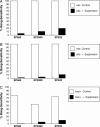Seizure suppression by gain-of-function escargot mutations
- PMID: 15654097
- PMCID: PMC1449553
- DOI: 10.1534/genetics.104.036558
Seizure suppression by gain-of-function escargot mutations
Abstract
Suppressor mutations provide potentially powerful tools for examining mechanisms underlying neurological disorders and identifying novel targets for pharmacological intervention. Here we describe mutations that suppress seizures in a Drosophila model of human epilepsy. A screen utilizing the Drosophila easily shocked (eas) "epilepsy" mutant identified dominant suppressors of seizure sensitivity. Among several mutations identified, neuronal escargot (esg) reduced eas seizures almost 90%. The esg gene encodes a member of the snail family of transcription factors. Whereas esg is normally expressed in a limited number of neurons during a defined period of nervous system development, here normal esg was expressed in all neurons and throughout development. This greatly ameliorated both the electrophysiological and the behavioral epilepsy phenotypes of eas. Neuronal esg appears to act as a general seizure suppressor in the Drosophila epilepsy model as it reduces the susceptibility of several seizure-prone mutants. We observed that esg must be ectopically expressed during nervous system development to reduce seizure susceptibility in adults. Furthermore, induction of esg in a small subset of neurons (interneurons) will reduce seizure susceptibility. A combination of microarray and computational analyses revealed 100 genes that represent possible targets of neuronal esg. We anticipate that some of these genes may ultimately serve as targets for novel antiepileptic drugs.
Figures



Similar articles
-
Genetic suppression of seizure susceptibility in Drosophila.J Neurophysiol. 2001 Sep;86(3):1211-25. doi: 10.1152/jn.2001.86.3.1211. J Neurophysiol. 2001. PMID: 11535671
-
The mei-P26 gene encodes a RING finger B-box coiled-coil-NHL protein that regulates seizure susceptibility in Drosophilia.Genetics. 2005 Aug;170(4):1677-89. doi: 10.1534/genetics.105.043174. Epub 2005 Jun 3. Genetics. 2005. PMID: 15937125 Free PMC article.
-
Seizure suppression by top1 mutations in Drosophila.J Neurosci. 2007 Mar 14;27(11):2927-37. doi: 10.1523/JNEUROSCI.3944-06.2007. J Neurosci. 2007. PMID: 17360915 Free PMC article.
-
Drosophila sodium channel mutations: Contributions to seizure-susceptibility.Exp Neurol. 2015 Dec;274(Pt A):80-7. doi: 10.1016/j.expneurol.2015.06.018. Epub 2015 Jun 18. Exp Neurol. 2015. PMID: 26093037 Free PMC article. Review.
-
Seizure and epilepsy: studies of seizure disorders in Drosophila.Int Rev Neurobiol. 2011;99:1-21. doi: 10.1016/B978-0-12-387003-2.00001-X. Int Rev Neurobiol. 2011. PMID: 21906534 Free PMC article. Review.
Cited by
-
Mutations in the K+/Cl- cotransporter gene kazachoc (kcc) increase seizure susceptibility in Drosophila.J Neurosci. 2006 Aug 30;26(35):8943-54. doi: 10.1523/JNEUROSCI.4998-05.2006. J Neurosci. 2006. PMID: 16943550 Free PMC article.
-
Calcium Imaging of Neuronal Activity in Drosophila Can Identify Anticonvulsive Compounds.PLoS One. 2016 Feb 10;11(2):e0148461. doi: 10.1371/journal.pone.0148461. eCollection 2016. PLoS One. 2016. PMID: 26863447 Free PMC article.
-
Phospholipid Homeostasis Regulates Dendrite Morphogenesis in Drosophila Sensory Neurons.Cell Rep. 2017 Oct 24;21(4):859-866. doi: 10.1016/j.celrep.2017.09.089. Cell Rep. 2017. PMID: 29069593 Free PMC article.
-
Seizure suppression through manipulating splicing of a voltage-gated sodium channel.Brain. 2015 Apr;138(Pt 4):891-901. doi: 10.1093/brain/awv012. Epub 2015 Feb 12. Brain. 2015. PMID: 25681415 Free PMC article.
-
Seizure-suppressor genes: can they help spearhead the discovery of novel therapeutic targets for epilepsy?Expert Opin Ther Targets. 2023 Jul-Dec;27(8):657-664. doi: 10.1080/14728222.2023.2248375. Epub 2023 Aug 22. Expert Opin Ther Targets. 2023. PMID: 37589085 Free PMC article. Review.
References
-
- Aberle, H., A. P. Haghighi, R. D. Fetter, B. D. McCabe, T. R. Magalhaes et al., 2002. wishful thinking encodes a BMP type II receptor that regulates synaptic growth in Drosophila. Neuron 33: 545–558. - PubMed
-
- Ashburner, M., 1989 Drosophila: A Laboratory Handbook. Cold Spring Harbor Laboratory Press, Cold Spring Harbor, NY.
-
- Ashraf, S. I., and Y. T. Ip, 2001. The snail protein family regulates neuroblast expression of inscuteable, and string, genes involved in asymmetry, and cell division in Drosophila. Development 128: 4757–4767. - PubMed
Publication types
MeSH terms
Substances
Grants and funding
LinkOut - more resources
Full Text Sources
Medical
Molecular Biology Databases
Research Materials

